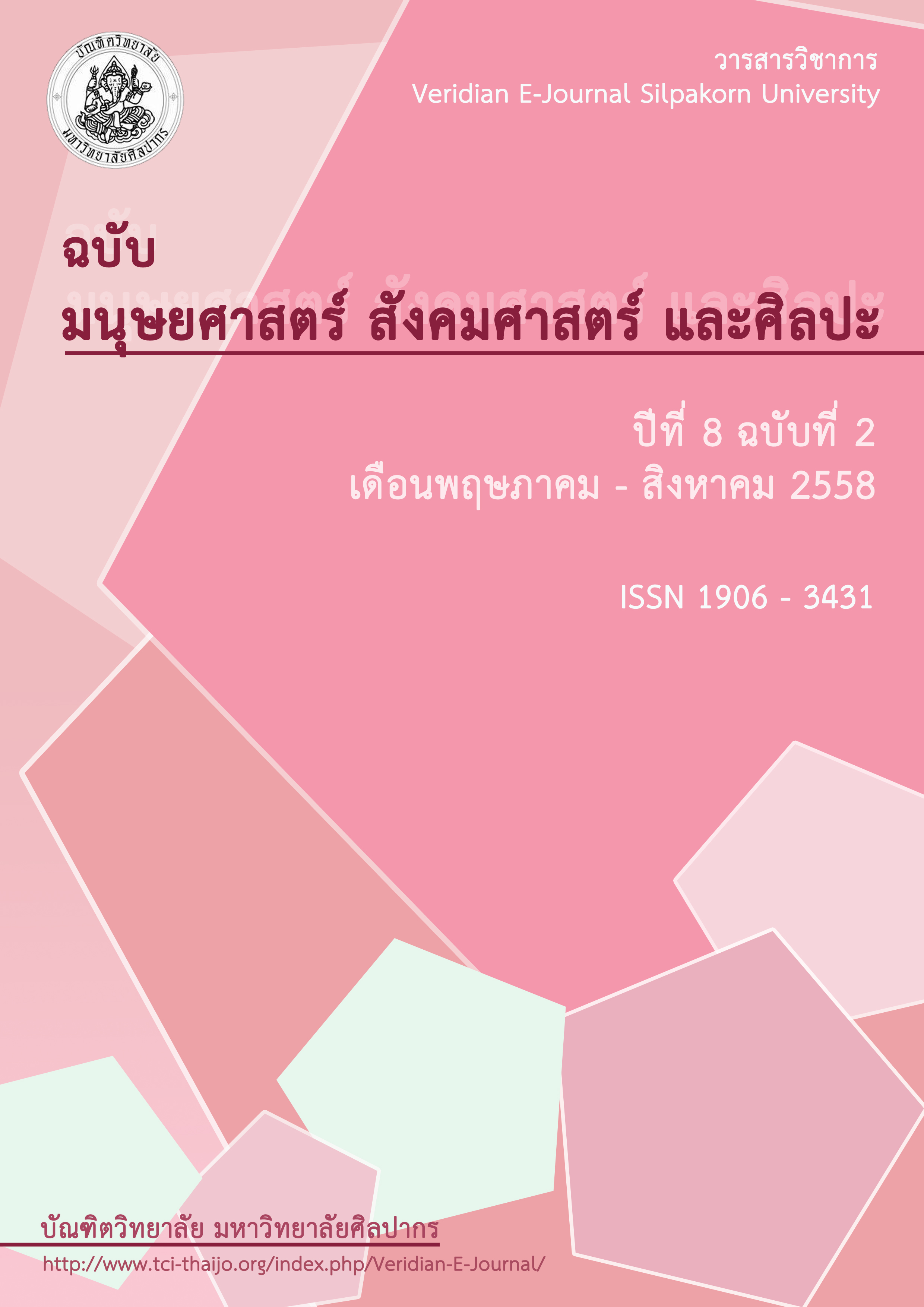ผลการใช้กิจกรรมศิลปะเชิงพหุปัญญาตามแนวคิดของโฮเวิร์ด การ์ดเนอร์ ที่ส่งเสริมความสุขและทักษะทางศิลปะในเด็กปฐมวัย
Main Article Content
Abstract
บทคัดย่อ
การวิจัยครั้งนี้มีวัตถุประสงค์เพื่อ 1) การศึกษาความสุขของเด็กปฐมวัยโดยใช้กิจกรรมศิลปะเชิงพหุปัญญาตามแนวคิดของโฮเวิร์ด การ์ดเนอร์ 2) ผลการศึกษาทักษะทางศิลปะของเด็กปฐมวัยโดยใช้กิจกรรมศิลปะเชิงพหุปัญญาตามแนวคิดของโฮเวิร์ด การ์ดเนอร์ และ 3) ผลการศึกษาความพึงพอใจของเด็กปฐมวัยต่อรูปแบบกิจกรรมศิลปะเพื่อส่งเสริมความสุขและทักษะทางศิลปะเชิงพหุปัญญาตามแนวคิดของ โฮเวิร์ด การ์ดเนอร์ โดยมีกลุ่มตัวอย่างที่ใช้ในการทดลองคือ นักเรียนชั้นอนุบาล 3 โรงเรียนสาธิตมหาวิทยาลัยศิลปากร ปฐมวัยและประถมศึกษา (ปฐมวัย) จำนวน 50 คน ทดลองในภาคเรียนที่ 1 ปีการศึกษา 2557 ใช้เวลาในการทดลองสัปดาห์ละ 2 ครั้ง ครั้งละ 50 นาที เป็นระยะเวลา 8 สัปดาห์ รวมทั้งหมด 16 คาบเรียน
เครื่องมือที่ใช้ในการวิจัยครั้งนี้ คือ กิจกรรมศิลปะเชิงพหุปัญญาตามแนวคิดของ โฮเวิร์ด การ์ดเนอร์ ที่ส่งเสริมความสุขและทักษะทางศิลปะในเด็กปฐมวัย แบบประเมินความสุข ก่อนและหลังทดลอง แบบประเมินทักษะศิลปะสำหรับเด็กปฐมวัย และ แบบสอบถามความพึงพอใจสำหรับเด็กปฐมวัย การวิเคราะห์ข้อมูล โดยหาค่าสถิติพื้นฐานของคะแนนเฉลี่ยร้อยละ มัชฌิมเลขคณิต (Mean) และส่วนเบี่ยงเบนมาตรฐาน (Standard Deviation) ของกลุ่มทดลองและกลุ่มควบคุม และการทดสอบค่า (t – test) แบบ Dependent
ผลการวิจัย พบว่า
1. ผลสัมฤทธิ์ความสุขของเด็กปฐมวัยจากการร่วมกิจกรรมก่อนและหลังด้วยกิจกรรมเชิงพหุปัญญาตามแนวคิดของโฮเวิร์ด การ์ดเนอร์เพื่อส่งเสริมความสุขและทักษะศิลปะของเด็กปฐมวัย มีผลสัมฤทธิ์หลังเรียนสูงกว่าก่อนเรียนอย่างมีนัยสำคัญทางสถิติที่ระดับ 0.01 ซึ่งเป็นไปตามสมมติฐานที่ตั้งไว้ โดยผลก่อนร่วมกิจกรรมศิลปะ (= 42.93) และผลหลังร่วมกิจกรรมศิลปะ (= 49.77) และค่า T – test เท่ากับ 8.67
2. ทักษะศิลปะของเด็ก หลังการเข้าร่วมกิจกรรมเชิงพหุปัญญาตามแนวคิดของโฮเวิร์ด การ์ดเนอร์เพื่อส่งเสริมความสุขและทักษะศิลปะของเด็กปฐมวัยในภาพรวมอยู่ในระดับสูง (=7.82 และมีค่าส่วนเบี่ยงเบนมาตรฐาน S.D. = 1.40)
3. ความพึงพอใจต่อกิจกรรมเชิงพหุปัญญาตามแนวคิดของโฮเวิร์ด การ์ดเนอร์เพื่อส่งเสริมความสุขและทักษะศิลปะของเด็กปฐมวัยในภาพรวมอยู่ในระดับมากที่สุด (= 9.31) S.D. = 1.53) และ เด็กๆ มีพฤติกรรมสนใจต่อการเรียนรู้ในระดับมากที่สุด
คำสำคัญ : ชุดกิจกรรม / ศิลปะเชิงพหุปัญญา / ศิลปะเด็กปฐมวัย / ความสุขของเด็กปฐมวัย
Abstract
The effect of multiple intelligences art education follow to Howard gardner to enhance happiness and art skill on childhood
This study aimed to 1) Study the happiness of the early childhood students implementing the art activities based on Multiple-Intelligences Arts Education according to Howard Garner’s theory, 2) Investigate the art skills of the early childhood students implementing the art activities based on Multiple-Intelligences Arts Education according to Howard Garner’s theory, and 3) Discover the satisfaction of the early childhood students towards the art activities based on Multiple-Intelligences Arts Education according to Howard Garner’s theory. The sample of the study was 50 students in Kindergarten 3, Demonstration School of the Faculty of Education, Silpakorn University (Early Childhood and Elementary). The study was conducted in the first semester of 2014. The experiment covered eight weeks or 16 periods; 50 minutes for one period.
The experimental instruments of the study consisted of 1) A set of the art activities based on Multiple-Intelligences Arts Education according to Howard Garner’s theory, 2) An evaluation form of the early childhood students’ happiness, 3) An evaluation form of the early childhood students’ artistic skills, and 4) A set of questionnaire for the satisfaction of early childhood students towards the art activities based on Multiple-Intelligences Arts Education according to Howard Garner’s theory. The collected data from the experimental and controlled group were analyzed by employing percentage, mean, Standard Deviation (S.D.) and the T-test Dependent.
The findings were revealed as follows:
1) The average scores of the early childhood students’ happiness before and after the implementation of the art activities based on Multiple-Intelligences Arts Education according to Howard Garner’s theory were 42.93 and 49.77 respectively. The artistic
achievement of the students before and after the implementation of the art activities based on Multiple-Intelligences Arts Education according to Howard Garner’s theory was significantly different at the level of 0.01.
2) The artistic skills of the early childhood students after the implementation of art activities based on Multiple-Intelligences Arts Education according to Howard Garner’s theory was in the high level; = 7.82, and S.D. = 1.40.
3) The satisfaction of the early childhood students towards art activities based on Multiple-Intelligences Arts Education according to Howard Garner’s theory was in the highest level; = 9.31, and S.D. = 1.53. The interest of the early childhood students towards the art activities was in the highest level as well.
KEY WORD : a set of art activities / multiple-intelligences arts education / art for early childhood students/ the happiness of early childhood students
